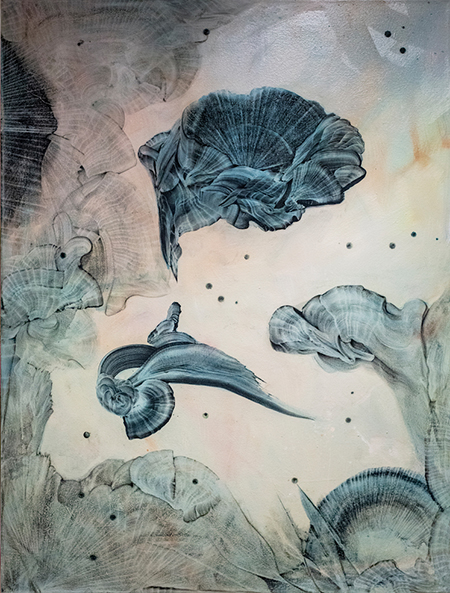
Continuing through January 4, 2020
This show of some 80 paintings by the late Virgil Grotfeldt, who died in 2009 at age 60 after a decade of living with cancer, reveals much of his aesthetic preoccupation with this personal subject matter. His last exhibition, opening just three weeks before his death, included 18 paintings utilizing MRI scans of his brain for their ground. These remarkable works are presented in a discrete inner gallery space, their undulating aquatic images executed in white, gray and pale blue oil on black X-rays. Grotfeldt transformed photographic records of his brain cancer into expressive paintings with broad and vital reference.
The rest of the works here pre-date this climax. More than a dozen paintings of dominating scale fill the front gallery. Darkly luminous, they are a product of Grotfeldt’s use of bronze powder, which he suspended in acrylic paint and used to achieve distinctive biomorphic abstractions on black backgrounds. Titles such as “Inner Space,” “The Messenger” and “Points Beyond Light” reveal his interest in both microscopic images and a vast universe filled with galaxies, gases and dark matter. Paintings like “Seahorse,” “Night Nymph” and “Healing Plants” signify Grotfeldt’s keen observations of the world around him.
Other equally compelling pieces are executed on found papers such as geological maps, Braille text, ledger paper and blueprints. The backgrounds add another layer to the delicate washes of subdued color and precisely drawn forms that can be interpreted as sea organisms, cellular images or exploding stars. Grotfeldt constantly experimented with fresh and varied materials, including carbon, coal dust, rice paper, metallic paper, vinyl and nano photographs.
In 1997 Grotfeldt wrote that “the anthropological, sociological, and geological composition of our world is my source of truth.” Although his work is deeply connected to nature, there are symbolic and psychological elements that elevate it beyond reproduction. His paintings encompass the cycles of life: reproduction and birth, growth and development, death and decay. This is archetypal imagery that transcends the mundane and engenders in us a sense of awe toward the great mysteries of life.
